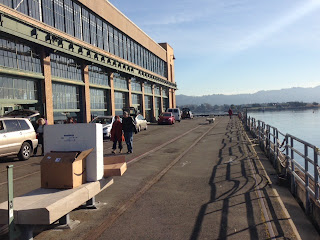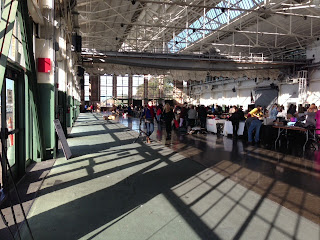Don’t get me wrong. The books were the stars of CODEX 2013, as they always are. Meeting and reconnecting with artists, getting a sneak preview of a book in-progress, or listening intently as an artist walked his or her listeners through a book that took years to complete—all of this captures the essence of CODEX. But this CODEX offered an added allure that was all about the space, and I returned home haunted by one of the snapshots I took that first morning. Since I enjoyed the path it opened up for me, I thought you might, too, after I’ve carried us through my other musings.
Here’s the photo, on the right:
In previous years
the CODEX Book Fair and Symposium has taken place in two buildings on the UC
Berkeley campus. Because of construction in Pauly Ballroom, the 2013 Fair was
moved to Craneway Pavilion, the former Ford Assembly Plant designed by Albert
Kahn and built in 1931.
Early that Sunday
morning, February 10th, artists and ravenous book collectors arrived together
on shuttle buses and filed into the space amid a collective gasp. Those of us
not tied to setting up were free to wander the aisles and stroll outside as
books found their way onto tabletops. And the space itself demanded equal attention:
theatrical was the word.
The former Ford factory, requisitioned during WW II
into a tank manufacturing plant, is situated on (right on) San Francisco Bay. As the story goes (so a visiting park
service ranger told us), as the tanks were finished they were literally rolled right
on board ship. Far from cold and dreary, the rejuvenated space is lit by 40,000
panes of glass and, far above, Kahn’s sawtooth-designed roof tucks in two lines
of clerestory windows that run along the building’s length. For this
sun-starved Midwesterner and for every visitor arriving from East of the
Mississippi, this was a gift.
 The Pavilion’s proximity
to water added another element. At any time, talking with an artist or
engrossed in a book, a reader might glance up to see a sailboat silently
powering past on its way out to open water. Within sight and not far away, a
trawler and a US Navy ship sat moored at anchor. Despite the fact that artists
and admirers had to occasionally resort to dark glasses (lending it a Hollywood
air! Berkeley’s Oscars!) as the south-facing windows tracked the sun’s
trajectory throughout the afternoon, the
The Pavilion’s proximity
to water added another element. At any time, talking with an artist or
engrossed in a book, a reader might glance up to see a sailboat silently
powering past on its way out to open water. Within sight and not far away, a
trawler and a US Navy ship sat moored at anchor. Despite the fact that artists
and admirers had to occasionally resort to dark glasses (lending it a Hollywood
air! Berkeley’s Oscars!) as the south-facing windows tracked the sun’s
trajectory throughout the afternoon, the
sun’s rays were, all in all, much welcomed.
When surfeited
with great work, I would walk/stagger out to the adjacent parkway to
breathe the air and track the course of bicycles and boats. To reach that Eastern
side, one exited the building between a pop-up café and a raised eating/viewing
area. Outside, an expansive Eucalyptus tree perfumed the air. Reentering, the
visitor beheld the full interior expanse.
Look up, and see the massive dividing
curtains ruched and held, up in the rafters, along with spotlights awaiting the
next event. Clearly, the theatre of the book had expanded to fill the theatre
of the space, the performance place of books. I later learned that one of the
building’s previous incarnations had been a book depository. No permanent deposits
here, just momentary stagings in hopes of securing for each book an ultimate
home.
 |
| Ines von Ketelhodt and Peter Malutzki |
And here’s a
question that always seems to arise: why are book fairs so exhausting? Besides
the standing and walking, talking and looking, I think a quieter, subliminal depletion
ticks away just under the conversations and musings. On both sides of the table
there is an understanding that every encounter at a book fair is fleeting and valuable.
All that content and beauty, unsettling or operatic, all of that passion poured
into each work has to go somewhere as artist and listener meet for an exchange
of sorts. So the artist conveys the book’s story along with his or her emotional
resonance to the viewer, who chooses to live with it for that moment and often
long afterward. Conversation by conversation and book by book, the intellectual
and emotional content accrues in the visitor, as if it has been absorbed into
the reader’s hands while reading, held and then handed back, and carried into
the next reader’s hands, the next heard story. Add to that the stress by both
artist and collector (how many books?
which stories to take home? Which artists did I not see? What did I miss?), and
the whole exchange multiplied many times over takes a toll, an exhaustion replete with color and language and a body memory of cradling, concentrating, absorbing.
 |
| Dan Mayer Studios & Pyracantha Press |
I wish I had the time to write at length about the many great books I had the luck to hold and learn about. Instead, let me note one unique and distinctive pleasure of a book fair, which is the privilege of a preview, the sneak peak, the lifting of the veil (curtain!) into the artist’s process. I am always humbled by the courage on an artist’s part, to invite the viewer into that private process fraught with the unknown.
 |
| Julie Chen, Flying Fish Press, Praxis (Illustrated), in-process |
These midway
viewings reveal layers in the palimpsest of making that will soon be covered up
by other actions on the artist’s part. This book fair I caught a glimpse of three
in-process books. Julie Chen’s Praxis (Illustrated) seen here on the left,
to be published by The Letterpress and Book Arts Center at Ringling College of
Art + Design in Sarasota. This book once again demonstrates Julie’s
mastery of structure, color, and the memoir transformed into universal truth.
Try to not pick this book up and live
with it. Impossible.
 |
| Gaylord Schanilec, leaning over the end grain Maple blocks on which he engraved the fold-out map of Lake Pepin for Lac des Pleurs |
His earlier books, such as Sylvae and Mayflies of the Driftless Region, capture the intersection of related stories to the subject, that refract out from its beginning, and slowly entrance a reader into following those threads that weave into a larger whole, a world-within-a-world. This will be another world, and I can’t wait to live in it. In particular, visitors were fascinated by Lac des Pleurs’ custom-marbled papers, created by Jemma Lewis and based on one of her patterns, but adjusted and painted in a color palatte derived from Gaylord’s photograph of wet stones along the shore of the lake. The pattern truly resembles stones under water, and yet, it doesn’t. I swear I saw the water move.
 |
| Lac des Pleurs's custom-marbled papers (on left) by Jemma Lewis, with Schanilec's photo on the right |
My third in-process find was Robin Price’s Love in the Time of War by Yusef Komunyakaa (below). I was struck by the book’s dark, crisp, semi-translucent sheets of hand-dyed and -painted silk, whose shifting earth tones suggested Camouflage (I later read that this visual reference was Robin’s intention for the book’s etched aluminum covers), or perhaps, as I followed that thought, the sheets suggested the earth re-absorbing war’s detritus, evidence of lost life.
 |
| Robin Price's in-process Love in the Time of War by Yusef Komunyakaa |
After all these
travels in conversations, books and reflections, I returned to Minnesota and to yet
more snow and cold, which returned me to that snapshot taken as the sailboat
glided past, as a booklover stopped to look up and out through the many-paned
windows and into the indistinct lighted water reflection, ghostly and inviting.
Finally, finally, after mastering my new snowblower and returning inside to hot
tea, the reference revealed itself:
 |
| Caspar David Friedrich, Wanderer above a Sea of Fog, ca. 1818 |
Caspar David Friedrich
made the concept of the sublime a central concern to the Romantic Movement. Beginning in the
late 18th century and lasting until the middle of the 19th century, Romanticism
exalted individualism, subjectivism, irrationalism, imagination, emotions and
nature as opposed to the rationalism
that characterized the Enlightenment and the established values of the social
order in general.
Friedrich’s pictured
figure has just ascended to an outcrop, leaning on his cane as he gazes out into
the mist threading through the rocks and mountains beyond. He is captivated by
this mysterious, primal landscape, and his way forward is not clear, perhaps
threatening, or at least confused. He must turn back, descend, return, but not
just yet. What is hidden in the mist? The walker looks outward, but we intuit
that he is just as strongly gazing inward. We may be looking with him at his subconscious, the limitlessness of the unknown. The subject has often been suggested to represent the artist himself.
I am relieved to
have found my visual wellspring, and amused
that in finding it, I was in turn carried a great distance. I hope it has carried you forward as well, and that you settle in tonight with a good book…no, a great
book, and keep looking out, into the light and mist.




